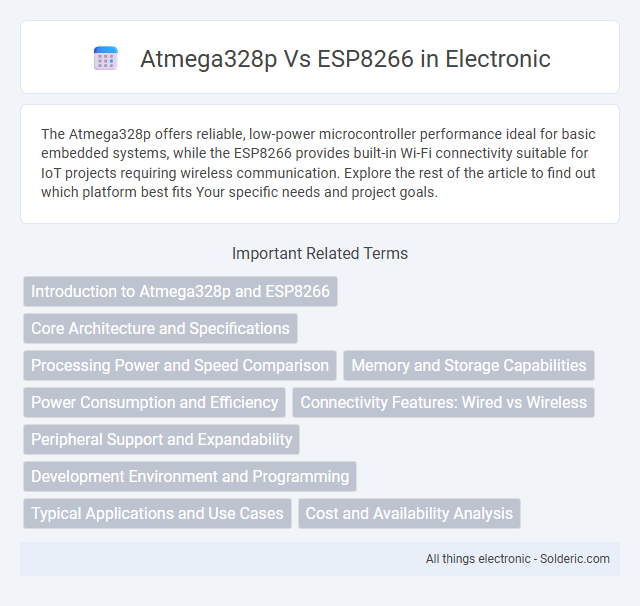The Atmega328p offers reliable, low-power microcontroller performance ideal for basic embedded systems, while the ESP8266 provides built-in Wi-Fi connectivity suitable for IoT projects requiring wireless communication. Explore the rest of the article to find out which platform best fits Your specific needs and project goals.
Comparison Table
| Feature | Atmega328p | ESP8266 |
|---|---|---|
| Microcontroller Type | 8-bit AVR | 32-bit Tensilica LX106 |
| Clock Speed | 16 MHz | 80-160 MHz |
| Flash Memory | 32 KB | Up to 4 MB |
| SRAM | 2 KB | 64 KB |
| Wi-Fi | No | 802.11 b/g/n |
| GPIO Pins | 23 | 17 |
| ADC Channels | 6 (10-bit) | 1 (10-bit) |
| Power Consumption | Low (around 20 mA active) | Higher (up to 170 mA peak) |
| Price | Low | Low to moderate |
| Typical Use Case | Basic embedded systems, simple sensor control | IoT devices, Wi-Fi-enabled applications |
Introduction to Atmega328p and ESP8266
Atmega328p is a popular 8-bit microcontroller from the AVR family, widely used in Arduino Uno boards due to its low power consumption and ease of programming. ESP8266 is a highly integrated Wi-Fi microchip with a full TCP/IP stack and microcontroller capability, designed for IoT applications requiring wireless connectivity. Both chips serve different roles: Atmega328p excels in simple embedded control, while ESP8266 specializes in networked communication and smart device integration.
Core Architecture and Specifications
The Atmega328p features an 8-bit AVR RISC architecture with a clock speed up to 20 MHz, 32 KB of flash memory, 2 KB of SRAM, and 1 KB of EEPROM, making it ideal for low-power, real-time applications. In contrast, the ESP8266 boasts a 32-bit Tensilica L106 microcontroller running at 80 to 160 MHz, with integrated Wi-Fi connectivity, 64 KB of instruction RAM, 96 KB of data RAM, and external flash up to 16 MB, enabling advanced IoT applications requiring faster processing and network communication. Your choice between these two microcontrollers should consider the balance between simplicity, power consumption, and connectivity needs.
Processing Power and Speed Comparison
The Atmega328p operates at 16 MHz with an 8-bit AVR architecture, providing reliable performance for basic microcontroller applications. In contrast, the ESP8266 features a 32-bit Tensilica processor clocked up to 160 MHz, delivering significantly higher processing power and speed for more demanding tasks. Your projects requiring fast computation and complex networking will benefit greatly from the ESP8266's superior performance capabilities.
Memory and Storage Capabilities
The Atmega328p features 32 KB of Flash memory, 2 KB of SRAM, and 1 KB of EEPROM, providing limited storage suitable for simple embedded applications. In contrast, the ESP8266 offers up to 160 KB of RAM and external Flash memory options ranging from 512 KB to 16 MB, enabling more complex programs and larger data storage. Your choice between these microcontrollers depends on the memory and storage requirements of your IoT or embedded system project.
Power Consumption and Efficiency
The Atmega328p microcontroller typically operates with a power consumption of around 0.2 mA in active mode and drops to microamps in sleep mode, making it highly efficient for battery-powered applications. In contrast, the ESP8266 Wi-Fi module consumes about 70-80 mA during active Wi-Fi transmission, significantly higher than Atmega328p, though it offers integrated Wi-Fi connectivity. For low-power, efficient tasks without network requirements, Atmega328p is preferable, whereas ESP8266 is suited for IoT applications demanding wireless communication despite higher energy usage.
Connectivity Features: Wired vs Wireless
The Atmega328p microcontroller primarily supports wired connectivity through UART, SPI, and I2C interfaces, making it ideal for direct hardware communication and control. In contrast, the ESP8266 excels in wireless connectivity by offering built-in Wi-Fi capabilities, enabling seamless integration with IoT networks and remote device management. While Atmega328p emphasizes robust wired protocol support, the ESP8266's wireless features provide greater flexibility for internet-based applications and real-time data transmission.
Peripheral Support and Expandability
The Atmega328p features limited peripheral support with 23 general-purpose input/output pins, ADC channels, and basic communication interfaces such as UART, SPI, and I2C, making it suitable for simple embedded projects. The ESP8266 offers enhanced peripheral integration, including PWM, ADC, I2C, UART, SPI, and Wi-Fi connectivity, allowing for more advanced and connected applications. Expandability is greater on the ESP8266 due to its built-in wireless capabilities and support for various IoT protocols, while the Atmega328p requires external modules to achieve similar network functionality.
Development Environment and Programming
The Atmega328p is primarily programmed using the Arduino IDE with C/C++ code, offering a simple, stable development environment well-suited for embedded applications with direct hardware manipulation. The ESP8266 supports both the Arduino IDE and Lua scripting via NodeMCU, providing greater flexibility and integrated Wi-Fi capabilities for IoT projects. Development for ESP8266 can leverage its built-in TCP/IP stack and higher processing power, making it ideal for network-connected applications requiring more complex programming.
Typical Applications and Use Cases
The Atmega328p excels in traditional embedded systems such as home automation, robotics, and sensor interfacing due to its low power consumption and ease of programming with Arduino IDE. The ESP8266 is favored for IoT applications requiring Wi-Fi connectivity, including smart home devices, remote monitoring, and wireless data logging. Both microcontrollers are often combined where the Atmega328p handles sensor data processing and the ESP8266 manages wireless communication for seamless IoT integration.
Cost and Availability Analysis
The Atmega328p microcontroller typically costs around $2 to $3 per unit, making it a highly affordable choice for basic embedded projects, while the ESP8266 module ranges from $3 to $5, offering integrated Wi-Fi capabilities at a slightly higher price point. Availability for the Atmega328p remains stable due to widespread use in Arduino platforms and established supply chains, whereas the ESP8266 faces occasional supply constraints caused by high demand in IoT applications. Bulk purchasing options and multiple manufacturers help mitigate cost and availability issues for both components, supporting scalable production for diverse electronics projects.
Atmega328p vs ESP8266 Infographic

 solderic.com
solderic.com